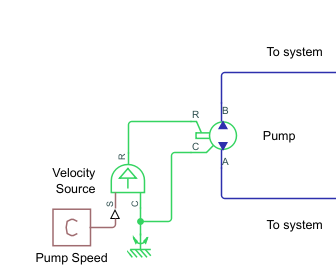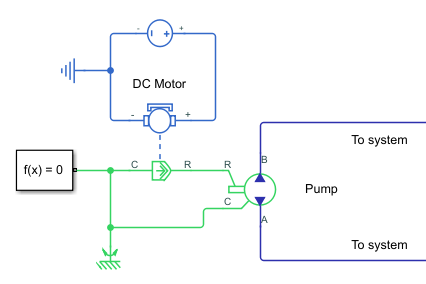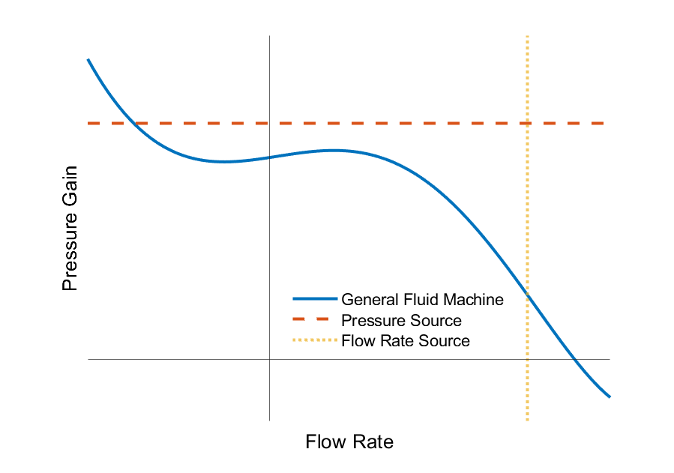Choosing a Fluid Power Source
When choosing a power source block for your model, you have to compromise between robustness, simulation speed, and accuracy. Simscape™ Fluids™ and Simscape offer a range of options for modeling power in a fluid system. Simscape libraries include an ideal source blocks for each domain. Simscape Fluids domain libraries include several fluid machines, such as pumps, fans, or compressors, depending on the domain.
Ideal Source Blocks
Ideal source blocks are the simplest way to add fluid power to your model. Ideal source blocks appear in the Simscape foundation library and include ideal pressure source and ideal flow rate source blocks, such as the Pressure Source (IL) or Flow Rate Source (IL) blocks. Ideal source blocks cannot capture complex dynamics, but are useful when:
You want to reduce model complexity. Because these blocks are simple, they are often helpful in first pass, proof of concept, or test harness models.
You do not model complex dynamics, which can be computationally expensive. Your model may run or compile faster.
You want to specify a pressure or flow rate value without considering the characteristics or limitations of specific fluid machines. This flexibility makes it easier to test different conditions during simulation, such as when you are analyzing sensitivity, optimizing your model, or exploring system behavior.
Depending on the application, if the pressure or flow rate in your physical system is or is close to constant, you may be able to use an ideal source block without a loss in accuracy.
Fluid Machine Blocks
Fluid machine blocks, which include pumps, compressors, and fans, capture more complex dynamics than ideal source blocks. Fluid machine blocks are useful when:
You want more accurate representations of power in a model. These blocks capture dynamic behavior, including pressure changes, flow rate variation, and power consumption, which are necessary for accurate system analysis, optimization, and design.
You want to more accurately represent specific component characteristics. The wide range of parameterization options in fluid machine blocks give you more control when specifying the block behavior. These parameterizations require more information about the system than ideal source blocks. You can populate some Simscape Fluids blocks with pre-parameterized manufacturing data to model a specific supplier component. For more information, see List of Pre-Parameterized Components.
Powering Fluid Machine Blocks
When using a fluid machine block, you must connect the mechanical rotational ports to a source to power the block. You can connect these ports to ideal sources, such as the Ideal Angular Velocity Source or Ideal Torque Source blocks, or an electric motor. The benefits and disadvantages of powering a fluid machine with an ideal source or an electric motor are the same as choosing an ideal source or a fluid machine for the model.
This figure shows a pump powered by a velocity source, which is simpler to set up and control.

This figure shows a pump powered by a simple motor. In this model, the feedback loop regulates the motor speed based on the torque, which can prevent modeling inaccuracies, such as unrealistic power supply.

If you have a Simscape Electrical™ license, you can also use motor blocks to more accurately model power supply. For example, this image shows a pump powered by a DC Motor (Simscape Electrical) block. Motor blocks modulate their power based on the physics of a model, which helps prevent instability or unrealistic scenarios that ideal source blocks can cause.

Comparing Fluid Machines and Ideal Source Blocks
Whether your block requires fluid machine or ideal source blocks depends on the amount of complexity you need to model. A significant advantage that fluid machines have over ideal source blocks is the modulation of Across and Through variables, which increases system stability. This figure shows the relationship between the Through and Across variables for ideal source blocks and a general fluid machine that does work on the fluid.

Ideal pressure source blocks model Across variable sources, and ideal flow rate source blocks model Through variable sources. Both types of ideal source block provide a constant pressure or flow rate regardless of system feedback, which can cause unrealistic system behavior. A fluid machine that does work on the fluid has a decreasing relationship between Through and Across variables.
For example, pump curves show the tradeoff between pressure and flow rate. You can decide between a larger pressure increase or flow rate, but in a physical system with a fixed power pump, you cannot have both. In a model, a pressure source block outputs a fixed pressure at any flow rate, and a flow rate source block outputs a fixed flow rate at every pressure. Ideal sources have no response to the system, and cannot model the relationship between Across and Through variables. Fluid machines account for the tradeoff, which allows them to respond to changes in the system and leads to an increase in stability.